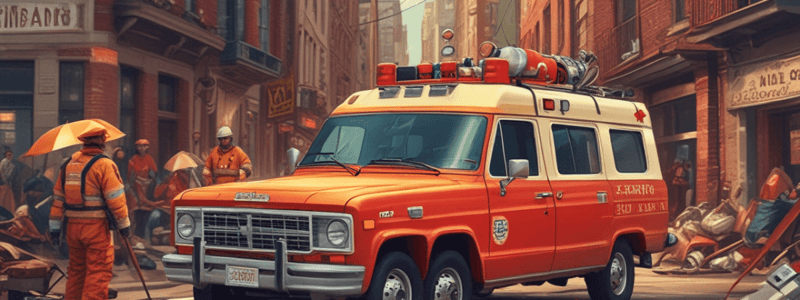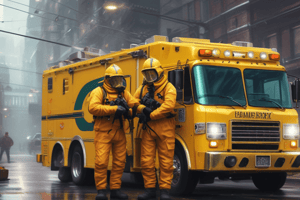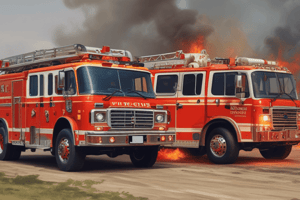Podcast
Questions and Answers
What should be done before accessing the patient in a vehicle stabilization scenario?
What should be done before accessing the patient in a vehicle stabilization scenario?
- Breaking the windshield to gain access
- Removing the roof to create more space
- Setting the parking brake, putting the vehicle in park, and turning off the engine (correct)
- Cribbing to stabilize the vehicle
Why should you try to open doors before using tools in vehicle access?
Why should you try to open doors before using tools in vehicle access?
- To avoid damage to the vehicle
- To release locking mechanisms and gain access (correct)
- To assess for potential hazards inside the vehicle
- To use the door as a makeshift stretcher
What type of glass should be broken in a vehicle access scenario?
What type of glass should be broken in a vehicle access scenario?
- Laminated glass, such as windshields
- Tempered glass, such as side and rear windows (correct)
- Tinted glass, such as rear windows
- Shattered glass, regardless of type
What should you do when breaking a window in a vehicle access scenario?
What should you do when breaking a window in a vehicle access scenario?
What should be done simultaneously with extrication in a patient extraction scenario?
What should be done simultaneously with extrication in a patient extraction scenario?
What should you do with undeployed airbags in a vehicle stabilization scenario?
What should you do with undeployed airbags in a vehicle stabilization scenario?
Why should you relieve pressure on the driver by moving the seat backwards on its track?
Why should you relieve pressure on the driver by moving the seat backwards on its track?
What is the purpose of removing the roof in a vehicle extraction scenario?
What is the purpose of removing the roof in a vehicle extraction scenario?
What is a characteristic of hydrogen sulfide?
What is a characteristic of hydrogen sulfide?
What should you assume about trenches?
What should you assume about trenches?
What should you do in cold water rescue?
What should you do in cold water rescue?
What is the purpose of the 'reach, throw, row, go' approach?
What is the purpose of the 'reach, throw, row, go' approach?
What is the primary difference between low-angle and steep-angle operations in rope rescue?
What is the primary difference between low-angle and steep-angle operations in rope rescue?
What is a characteristic of carbon monoxide?
What is a characteristic of carbon monoxide?
What should you do during a wilderness search and rescue?
What should you do during a wilderness search and rescue?
What is a hazard in confined spaces?
What is a hazard in confined spaces?
What is a characteristic of ammonia?
What is a characteristic of ammonia?
What is the goal of the 'search' part of wilderness search and rescue?
What is the goal of the 'search' part of wilderness search and rescue?
When responding to a structure fire, what should you do upon arrival at the scene?
When responding to a structure fire, what should you do upon arrival at the scene?
In agricultural industrial rescue, what is crucial to master?
In agricultural industrial rescue, what is crucial to master?
In tactical environments, what should tactical EMS personnel carry?
In tactical environments, what should tactical EMS personnel carry?
What is the primary cause of compartment syndrome?
What is the primary cause of compartment syndrome?
When packaging patients, what should be considered?
When packaging patients, what should be considered?
Why is it important to visit local farms and industrial plants in agricultural industrial rescue?
Why is it important to visit local farms and industrial plants in agricultural industrial rescue?
In tactical environments, what should be done immediately after treating a patient?
In tactical environments, what should be done immediately after treating a patient?
What type of equipment is commonly used in patient packaging?
What type of equipment is commonly used in patient packaging?
Flashcards are hidden until you start studying
Study Notes
Vehicle Stabilization and Access
- After cribbing, vehicles can still move, including horizontal, vertical, roll, bounce, and yaw movements
- Ensure parking brake is set, vehicle is in park, and turned off before accessing the patient
- Try to open doors before using tools, and release locking mechanisms to gain access
- Break tempered glass (side and rear windows) instead of laminated glass (windshields)
Glass Management
- Break a window that is not close to the patient to avoid glass shards
- Wear appropriate PPE and lower the window as far as possible before breaking
- Aim for a low corner and give a verbal warning before breaking glass
- Use a hand tool to clean out remaining glass fragments
Patient Extraction
- Begin initial care, assessment, and management of ABCDs and Es simultaneously with extrication
- Disentangle the patient by removing sheet metal and plastic, without cutting them out of the vehicle
- Protect the patient before disentangling and inform them of the process
- Perform only necessary procedures to disentangle the patient, determined by the incident specifics
Airbag Safety
- Identify any undeployed airbags, which are controlled by computers and may retain power for up to 30 minutes
- Disconnect the battery to allow the airbag capacitor to discharge if an airbag did not deploy
- Avoid placing hard objects between the patient and undeployed airbags, which can become projectiles
- Do not cut the steering wheel if the airbag has not deployed
Seat Displacement and Removal
- Relieve pressure on the driver and create more room to work by moving the seat backwards on its track
- Immobilize the patient and use manual seat releases or power adjustments if possible
- Perform a seat displacement if necessary, following a simple to complex approach
Windshield and Roof Removal
- Remove the windshield to improve communication, assessment, and patient removal
- Use specialized saws or axes to remove the windshield
- Remove the roof to increase space, provide a larger exit route, and improve air circulation
- Use hydraulic cutters and rams to displace the dashboard with the dash roll technique
Vehicle Stabilization and Access
- Vehicles can move in multiple directions after cribbing, including horizontal, vertical, roll, bounce, and yaw movements
- Ensure parking brake is set, vehicle is in park, and turned off before accessing the patient
- Try to open doors before using tools, and release locking mechanisms to gain access
- Break tempered glass (side and rear windows) instead of laminated glass (windshields) for safer access
Glass Management
- Break a window that is not close to the patient to avoid glass shards
- Wear appropriate PPE and lower the window as far as possible before breaking
- Aim for a low corner and give a verbal warning before breaking glass
- Use a hand tool to clean out remaining glass fragments after breaking
Patient Extraction
- Begin initial care, assessment, and management of ABCDs and Es simultaneously with extrication
- Disentangle the patient by removing sheet metal and plastic, without cutting them out of the vehicle
- Protect the patient before disentangling and inform them of the process
- Perform only necessary procedures to disentangle the patient, determined by the incident specifics
Airbag Safety
- Identify any undeployed airbags, which are controlled by computers and may retain power for up to 30 minutes
- Disconnect the battery to allow the airbag capacitor to discharge if an airbag did not deploy
- Avoid placing hard objects between the patient and undeployed airbags, which can become projectiles
- Do not cut the steering wheel if the airbag has not deployed
Seat Displacement and Removal
- Relieve pressure on the driver and create more room to work by moving the seat backwards on its track
- Immobilize the patient and use manual seat releases or power adjustments if possible
- Perform a seat displacement if necessary, following a simple to complex approach
Windshield and Roof Removal
- Remove the windshield to improve communication, assessment, and patient removal
- Use specialized saws or axes to remove the windshield
- Remove the roof to increase space, provide a larger exit route, and improve air circulation
- Use hydraulic cutters and rams to displace the dashboard with the dash roll technique
Hazards in Confined Spaces
- Oxygen deficiency can occur due to gases like hydrogen sulfide, found in swamps, sewers, and natural gas wells
- Hydrogen sulfide is heavier than air, displacing oxygen and causing a pungent odor
- Carbon monoxide is odorless, tasteless, and cannot be detected by normal senses, causing headaches, dizziness, and disorientation
- Carbon dioxide displaces oxygen, causing a sour taste and stinging sensation in the nose and mouth
- Methane is not toxic but can cause burns if ignited, and is often used as a fuel
- Ammonia is toxic and corrosive with a pungent odor, rising in the upper atmosphere
- Nitrogen dioxide is a reddish-brown gas with a sharp odor, prominent in air pollution and toxic by inhalation
Safe Approach in Confined Spaces
- Assume the environment is immediately dangerous to life and health (IDLH) and gather information from bystanders
- Test the air and assess atmospheric conditions before making entry
- Assist other responders by providing a situation report, comparing observed conditions, and sharing information
- Evaluate progress continuously and provide resources to the fire company and hazard materials teams
- Handle crowd control, bring rescue equipment, and maintain a charged hose line
Hazards in Trenches
- Trenches are unstable and prone to further collapse, requiring careful excavation and stabilization
- Patients should be carefully dug out after shoring has stabilized the excavation site
- Don't enter trenches until stabilization is complete to avoid secondary collapse
- Maintain personal safety by staying away from edges and shutting off heavy equipment
Water Rescue
- Self-rescue techniques include adopting a face-up arch position in fast-moving water and using hands to change direction
- In cold water rescue, assume the HELP (Heat Escape Lessening Position) to minimize movement and preserve heat
- Hypothermia can cause unconsciousness and death, requiring full resuscitation efforts
- In group victims, huddle together in cold water to conserve heat
- Cold water exposure can activate primitive reflexes, preserving bodily functions
Special Water Rescue Situations
- Swiftwater rescue involves people swept away by moving water, often from vehicles driving through flooded waters
- Hazards in swiftwater rescue include difficulty in determining water depth, hydraulics, and strainers
- Use the reach, throw, row, go approach in swiftwater rescue
- Utilize specialized equipment for ice rescues, such as ladders and flotation devices
Rope Rescue Incidents
- Low-angle operations involve slopes < 35°, using ropes for secondary support
- Steep-angle operations involve slopes between 35-60°, requiring specialized equipment and training
- High-angle operations involve slopes > 60°, relying solely on ropes for support
- Set up equipment appropriately, protect yourself, and move bystanders out of the way
Wilderness Search and Rescue
- Wilderness search and rescue involves two parts: searching for a lost person and removing them from a hostile environment
- Safe approach involves being aware of terrain and environmental factors, bringing necessary supplies, and wearing suitable clothing
- Set up a search base, prepare equipment ahead of time, and monitor progress via radio
- Keep the radio volume low, and only the IC is authorized to update the family
Structure Fires
- Determine a safe route to the scene, considering roadblocks and apparatus positioning
- Find a suitable parking spot for the ambulance, assessing for injured patients
- Remain with the ambulance until directed otherwise, staying present even after the fire is extinguished
- Be prepared to provide medical care to injured firefighters during salvage and overhaul
Agricultural Industrial Rescue
- Conduct pre-incident planning by visiting local farms and industrial plants to understand equipment operation and potential hazards
- Identify pinch points, wrap points, or shear points where operators can become entrapped
- Master cribbing and shoring techniques to create a stable platform for lifting
- Consider alternative disentanglement methods and patient assessment strategies
- Recognize differences between industrial and farm settings, including available resources and EMS response time
Tactical Environments
- Tactical EMS personnel require additional training and PPE identical to law enforcement officers
- Carry a compact kit for traumatic injury management, including bleeding control
- Provide immediate medical care to injured persons, often before the scene is deemed safe
- Follow specific guidelines for tactical responses, including light control, low profile, and proximity to the ambulance
Compartment Syndrome
- Compression of chest, abdomen, or limb for 4-6 hours causes oxygen deprivation and tissue damage
- Treat with positive pressure ventilation, sodium bicarbonate, calcium, and fluid administration
- Manage pain using pharmacologic and non-pharmacologic methods, including splinting and gentle handling
Patient Packaging
- Use Stokes baskets (wire or plastic/fiberglass) for off-road patient transport
- Consider patient needs, including oxygen supply, IV lines, and spinal motion restriction
- Secure patients to a full-body vacuum mattress or Ked/Sked combination when possible
- Avoid gravity-fed systems to minimize package height
- Prioritize patient warmth and provide head and eye protection
Studying That Suits You
Use AI to generate personalized quizzes and flashcards to suit your learning preferences.




